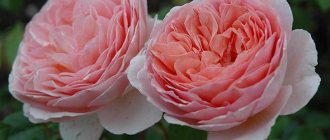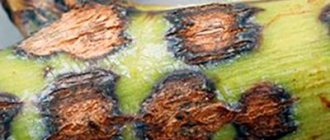Author: Elena N. https://floristics.info/ru/index.php?option=com_contact&view=contact&id=19 Category: Garden plants Published: February 03, 2019Last edits: November 17, 2020
- Growing conditions
- Reproduction methods
- Amur lilac (Syringa amurensis)
Lilac is a genus of shrubs of the Olive family, which according to various sources includes from 22 to 36 species growing in the mountainous regions of Eurasia. plant (lat. Syringa vulgaris) is the type species of the genus Lilac. In the wild, lilacs can be found on the Balkan Peninsula, along the lower reaches of the Danube, in the Southern Carpathians. In cultivation, lilac shrubs are used as an ornamental plant, as well as to protect and strengthen slopes subject to erosion. Lilacs began to be grown in European garden culture in the mid-16th century, after the Roman ambassador brought it from Constantinople. The Turks called the plant “lilac”, and in the gardens of Flanders, Germany and Austria they began to grow it under the name “Turkish viburnum” or “lilac”. In those days, lilac occupied a very modest position in European ornamental gardening due to its short flowering period, small flowers and loose panicles, but after the Frenchman Victor Lemoine began breeding the plant, several dozen varieties of long and lushly flowering lilacs with dense regular inflorescences appeared. forms. In addition, Lemoine created varieties of various colors with double flowers. After Victor, his son Emil and grandson Henri were engaged in lilac selection. In total, the Lemoines bred 214 varieties of lilac. In France, Charles Baltet, Auguste Gouchot and François Morel also carried out breeding work with lilacs, and in Germany - Ludwig Späth and Wilhelm Pfitzer. At the beginning of the 20th century, new varieties of lilac were bred in Holland by Jan van Tol, Klaas Kessen, Hugo Coster and Dirk Evelens Maarse, and in Poland by Karpov-Lipski. At the beginning of the 20th century, interest in lilac also arose in North America, where Gulda Klager, John Dunbar, Theodor Havemeyer and other famous breeders from the USA and Canada were involved in breeding new varieties of the plant. In the territory of the former USSR, breeding work with lilacs was carried out in Ukraine, Belarus, Kazakhstan and Russia. Today there are more than 2,300 varieties of lilac, differing in the shape and size of flowers, their color, flowering time, height and habit of the bushes. Two thirds of these varieties were obtained using the common lilac species.
Planting and caring for lilacs
- Flowering: early or mid-May, sometimes late April.
- Planting: from the second half of July to the beginning of September.
- Lighting: bright light, light partial shade.
- Soil: moderately moist, rich in humus, with a pH of 5.0-7.0.
- Watering: only in the first half of summer as the soil dries out. Water consumption for each bush is 25-30 liters. In the future, watering is carried out only during prolonged drought.
- Feeding: for the first 2-3 years, a little nitrogen fertilizer is applied to the bushes: from 1 to 3 buckets of slurry for each bush. Potassium-phosphorus fertilizers in the amount of 30-35 g of potassium nitrate and 35-40 g of double superphosphate for each adult bush are applied once every 2-3 years, followed by watering. However, the best fertilizer for lilacs is a solution of 200 g of ash in a bucket of water.
- Pruning: lilacs are pruned from the age of two in the spring, before the sap begins to flow.
- Reproduction: grafting, layering and cuttings.
- Pests: leaf or bud mites, hawk moths, lilac moths and leaf miners.
- Diseases: powdery mildew, bacterial (nectria) necrosis, verticillium and bacterial rot.
Read more about growing lilacs below.
Girlish blush
A delicate and graceful bush, reaching no more than two meters in height and width, yet it has lush inflorescences that abundantly cover the bush from the first years of growth. The flowers are pink with a light pearly sheen.
Early flowering occurs in early or mid-May, filling the garden with light notes of aromas and a neat appearance. The plant is unpretentious in choosing soil, but develops more actively in sunny areas with well-drained soil.
Botanical description
Lilac is a multi-stemmed deciduous shrub with a height of 2 to 8 m. Lilac trunks can reach a diameter of 20 cm. They are covered with gray or gray-brown bark, fissured on old trunks and smooth on young ones.
Lilac leaves bloom early, do not fall until frost and can reach a length of 12 cm. They are opposite, usually entire, sometimes pinnately divided. Depending on the type of lilac, the shape of the leaves can be oval, heart-shaped, ovoid, or elongated with a pointed tip. The leaf color is light or dark green. White, lilac, purple, blue, violet or pink flowers, collected in terminal drooping panicles up to 20 cm long, consist of a short bell-shaped four-toothed calyx, two stamens and a corolla with a long cylindrical tube and a flat four-parted limb. When does lilac bloom? Depending on the type of lilac, the climate of the area and the weather, flowering occurs from late April to early June. In any case, you will not miss this phenomenon: blooming lilacs will make themselves known with a subtle, delicate and very pleasant aroma. The fruit of the plant is a bivalve capsule in which several winged seeds ripen.
Under favorable conditions, lilacs live up to one hundred years. It does not require complicated care, is not afraid of frost and, along with hydrangea and mock orange, or garden jasmine, is one of the most popular ornamental shrubs.
- Potassium soap for plants is an excellent adhesive
Andenken an Ludwig Spath
A unique variety with dark purple inflorescences reaching 20-25 centimeters in diameter with a total crown span of up to three meters.
The bush itself grows up to 4 meters in height. The flowers are resistant to fading and retain their purple color throughout the flowering period. The formation of buds occurs in the first weeks of June. The variety has an unobtrusive scent, which is perfectly preserved when cut for bouquets.
Planting lilacs in the garden
When to plant
Lilac, unlike other shrubs and trees, is best planted from the second half of July to early September. Planting lilacs in spring or autumn is not advisable, since the plant does not take root well and produces virtually no growth in the first year. Plant lilacs in well-lit areas. The plant prefers moderately moist, humus-rich soils with a pH of 5.0-7.0.
When purchasing lilac seedlings, pay attention to the condition of their root system: it should be developed and well branched. Before planting, the roots are shortened to 30 cm, broken, diseased or dried roots are removed. Shoots that are too long are also shortened, and damaged ones are removed.
How to plant
Depending on the type and variety of plants planted, the distance between lilac seedlings should be from 2 to 3 m. How to plant lilacs in the garden? First you need to prepare planting holes with steep walls. The size of the holes in soils with good or average fertility should be 50x50x50 cm, and when planting in sandy or poor soil, the size is doubled with the expectation that when planting the hole will be filled with a fertile substrate consisting of humus or compost (15-20 kg ), superphosphate (20-30 g) and wood ash (200-300 g). If the soil on the site is acidic, then the amount of ash is doubled.
A layer of drainage material (expanded clay, crushed stone, broken brick) is placed at the bottom of the planting pit, on which a heap of fertile soil mixture is poured. The seedling is placed in the center of the hole on a hill, its roots are straightened and the hole is filled to the top with substrate. The root collar of the seedling should be 3-4 cm above the surface level. After planting, the plant is watered abundantly, and when the water is absorbed, the tree trunk circle is mulched with a layer of humus or peat 5-7 cm thick.
Beauty of Moscow
The culture blooms at the end of May with white flowers, occasionally having a light pearlescent tint. Even when buds form, the shrub has exceptional decorative properties due to its original color.
When the buds open, it attracts with an unforgettable aroma. The crown diameter is 2.5-3 meters, and the height of the bush is about 4 meters. The plant is unpretentious in care, but it is better to plant it in open ground from mid-summer to September, having previously fertilized the soil with organic matter.
Caring for lilacs in the garden
Growing conditions
Caring for lilacs in the garden will not be difficult even for a lazy gardener. How to grow lilacs? It will grow on its own, you only need to water it in the first half of summer as the soil dries, spending 25-30 liters of water per bush, and loosen the soil in its tree trunk circle to a depth of 4-7 cm 3-4 times per season, simultaneously removing weeds. In August and September, watering lilacs is carried out only in case of prolonged drought. In 5-6 years, with easy care, your seedling will turn into a lush bush.
As for fertilizing, in the first 2-3 years only a small amount of nitrogen is applied to lilacs: from the second year - 50-60 g of urea or 65-80 g of ammonium nitrate for each bush. Although organic fertilizers have a much more effective effect on the plant, for example, from 1 to 3 buckets of slurry for each plant. To obtain a solution, one part of cow dung is diluted in five parts of water. Fertilizer is applied into a shallow furrow dug along the perimeter of the tree trunk circle no closer than half a meter from the trunks.
Potassium and phosphorus fertilizers are applied once every 2-3 years at the rate of 30-35 g of potassium nitrate and 35-40 g of double superphosphate per adult plant. The granules are applied to a depth of 6-8 cm with mandatory subsequent watering. But the best complex fertilizer for lilacs is a solution of 200 g of ash in 8 liters of water.
Transfer
Transplanting lilacs 1-2 years after planting is a mandatory procedure for experienced gardeners. And here's why: lilac very quickly sucks all the nutrients out of the soil, even if you carried out regular fertilizing, so after two years the soil no longer contains the energy that the plant needs for intensive growth and bright flowering.
Three-year-old lilacs are replanted no earlier than August, and young bushes - at the end of spring, immediately after flowering, otherwise they will not have time to take root. First, planting holes are prepared as described earlier. Before replanting, inspect the bush, remove all damaged, dry and unnecessary lilac shoots and branches. Then the bush needs to be dug along the projection of the crown perimeter, removed from the ground along with the earthen lump, laid on oilcloth or dense fabric and moved to a new hole, which should be so much larger in volume than the earthen lump of the bush so that a significant amount of nutritious soil can be added to it. .
Trimming
Young plants under two years of age do not need pruning, since all their skeletal branches have not yet formed, but in the third year they need to begin forming a crown, which will take 2-3 years. Lilacs are pruned in the spring, before the sap begins to flow, until the lilac buds begin to swell: only 5-7 beautiful branches equidistant from each other are left, and the rest are cut off. Root shoots are also removed. Next year you will have to cut off about half of the flowering shoots. The principle of pruning is that no more than eight healthy buds are left on each skeletal branch, and the rest of the branch is pruned so as not to overload the plant during the flowering period. Simultaneously with formative pruning, sanitary pruning is also carried out: frozen, broken, diseased and improperly growing shoots are removed.
If you want to form a lilac in the form of a tree, you need to choose a seedling with a straight and strong vertical branch for planting, shorten it to the height of the trunk, and then form 5-6 skeletal branches from the growing shoots, while simultaneously clearing the stem and trunk circle of growth. When the standard lilac is formed, all you have to do is thin out the crown annually.
Care during flowering
In the spring, when warm weather sets in, the amazing smell of lilac spreads throughout the garden, which is very attractive to beetles. You will have to manually collect cockchafers from the bush. During the active flowering of lilacs, it is necessary to cut off about 60% of the flowering shoots - this is called pruning “for a bouquet” and is done to more intensively form new shoots and lay flower buds for next year. If you want the lilac branches to last longer in the vase, cut them early in the morning and split the bottom of each cut branch. When the bush fades, it is necessary to remove all wilted brushes from it.
Pests and diseases
Lilac is practically invulnerable to pests and harmful microorganisms, but under certain circumstances it can be affected by powdery mildew, bacterial necrosis, verticillium and bacterial rot, as well as leaf or bud mites, hawk moth, lilac moth and leaf miner.
- Stromantha at home, types and varieties
Bacterial, or nectria, necrosis appears in August: the green leaves of the lilac become ash-gray, and the young shoots turn brown or brown. To avoid damage, you need to thin out the crown of the plant, thereby increasing its ventilation, remove diseased areas and prevent pests from appearing on the lilac. If the damage is too strong, you will have to uproot the bush.
Bacterial rot affects the leaves, shoots, flowers and buds of lilac. It can also appear on the roots in the form of wet, rapidly growing spots. As a result of the development of the disease, the leaves lose turgor and dry out, but do not fall off immediately, the shoots dry out and bend. 3-4 treatments of lilac with copper oxychloride at an interval of 10 days will help you cope with the disease.
Powdery mildew is caused by a fungus and easily affects both young and mature plants: the leaves are covered with a loose grayish-white coating, which becomes dense and turns brown as the disease progresses. The disease progresses during dry, hot summers. When the first signs of the disease appear, the areas affected by the disease should be cut out and burned, and the bush should be treated with a fungicidal preparation. In early spring, the soil should be dug up with bleach at the rate of 100 g per m², being careful not to disturb the lilac roots.
Verticillium wilt is also a fungal disease that causes lilac leaves to curl, become covered with rusty or brown spots, dry out and fall off. Drying begins at the top of the bush and progresses very quickly. To stop the disease, you need to spray the bush with a solution of 100 g of laundry soap and 100 g of soda ash in 15 liters of water. Treatment of a diseased plant with Abiga-Peak is also effective. Affected areas should be trimmed and burned with fallen leaves.
The lilac hawk moth is a very large butterfly with a marbled pattern on the front wings, leading a nocturnal lifestyle. In the caterpillar stage, it is also quite large - up to 11 cm in length. You can also recognize it by its dense horn-shaped growth at the back of the body. Not only lilacs, but also viburnum, meadowsweet, ash, currants and grapes can become a victim of the hawkmoth caterpillar. The pest is destroyed by treating with a one percent solution of Phthalophos.
The lilac moth lives in light forests and hedgerows. It produces two generations in one season. As a result of the vital activity of its small caterpillars, only the veins rolled into a tube remain from the leaves, and the buds, flowers and buds disappear completely. The pest can be destroyed by treating lilacs with Karbofos or Fozalon.
The lilac leaf mite is a small insect that sucks juices from the underside of lilac leaves, causing them to dry out and turn brown. A large number of mites can destroy a large lilac bush in two weeks. To prevent this from happening, treat the plant leaves with a solution of copper or iron sulfate, do not forget to thin out the crown, feed the bush with potassium-phosphorus fertilizers and burn fallen leaves in the fall.
The lilac bud mite spends its life in the buds of plants: it feeds on their sap and overwinters in them. As a result, the buds become deformed, the leaves and shoots from them grow weak and underdeveloped, the lilac stops blooming and may die. To avoid such consequences, in early spring, as soon as the frosts have passed, remove dry leaves and root shoots from under the bush, dig up the soil in the tree trunk circle to the fullest extent, turning the earth over, and treat the lilac with a solution of copper sulfate.
Mining moths infect the leaves of plants, causing them to first become covered with dark brown spots (mines), and after a while they curl up into a tube, as if from fire. Sick bushes stop blooming and die within a year or two. The pest is destroyed by generously treating the leaves with Bordeaux mixture, a solution of Fitosporin-M or Baktofit, and for the purpose of prevention, it is necessary to remove and burn plant debris in the fall, and before frosts and in early spring, dig deep into the soil in the tree trunk circle.
Etoile de Mai
An elegant and delicate bush can become a decoration of a personal plot, both as a hedge and as a lonely growing shrub. Purple, with a red tint, the flowers have a spherical shape, petals with whitish edges, giving the entire inflorescence splendor and airiness.
During the first two years of growth, the seedling will not delight with abundant flowering even in a sunny place, but will require feeding in the form of humus or manure.
Lilac propagation
Reproduction methods
Seed propagation of lilac is carried out mainly by specialists in nurseries. In amateur gardening, varietal lilacs are propagated by grafting, layering and cuttings. Both own-rooted lilac seedlings grown from layerings and cuttings, as well as grafted ones, are available for sale. Own-rooted lilacs are not as capricious as grafted ones, they recover more easily after frosty winters, they reproduce well vegetatively and, therefore, are more durable.
Lilac grafting
The rootstock for varietal lilacs can be common lilac, Hungarian lilac and common privet. Lilacs can be budded in the summer with a dormant bud or in the spring with an awakening bud, and spring grafting is preferable, since the survival rate of cuttings at this time is quite high - about 80%. For spring budding, cuttings are prepared in February or March and kept in the refrigerator at a temperature of 0 to 4 ºC, wrapped in paper. Cuttings are taken from mature annual shoots on which the bark has already turned brown.
The rootstock is also prepared in advance: the side shoots are cut at a height of 15-20 cm, and the root shoots are removed. The thickness of the root collar of the rootstock should be no thinner than a pencil, and the bark should easily come away from the wood, for which the rootstock should be watered abundantly a week before grafting. On the day of grafting, the soil is raked away from the root neck of the rootstock, the grafting site is wiped with a damp, clean cloth, the rootstock stump is split in the center with a budding knife to a depth of 3 cm. The lower end of the scion cutting is cleaned on both sides to the same height to form a wedge, and the scion wedge is inserted into split the rootstock, completely immersing the areas cleared of bark into it, and wrap the grafting site with tape so that its sticky side faces outward. Then, all damage and places from which the buds were removed are treated with a garden varnish, and a plastic bag is placed on the grafted cuttings, fixing it to create a greenhouse effect below the grafting site. The bag is not removed until the buds on the scion begin to swell.
Budding is carried out on a dry, fine day from 5 to 10 am or in the evening, from 4 to 8 pm.
Reproduction by layering
To carry out this method of propagation, find a young shoot that is beginning to become lignified, pull it in the spring in two places (at the base, and also retreating another 80 cm) with copper wire, trying not to damage the bark, then lay the shoot in a groove 1.5-2 cm deep , leaving the top on the surface, and secure it in it with pins. When the shoots growing upward from the layering reach 15-17 cm, cover them with fertile soil to at least half the height. Do not forget to water the cuttings all summer, remove emerging weeds and add soil under the growing shoots 1-2 more times. With the onset of cold weather, the cuttings are separated at the constriction points, cut so that each part contains a shoot with roots, and the divisions are sent to the school for growing or immediately planted in a permanent place. Don't forget to protect young plants overwintering in the garden from the cold.
- Spirea pruning
Propagation by cuttings
Since lilac cuttings are difficult to root, two rules must be followed:
- cuttings should be harvested immediately after flowering or during it;
- cut cuttings in the morning from young plants, selecting non-lignified shoots of medium thickness with short internodes and 2-3 nodes from inside the crown.
The lower leaves are removed from the cuttings, the upper ones are shortened by half, the lower cut is made obliquely, and the upper one is made at a right angle. Lilac cuttings are dipped with an oblique cut into a solution of a root formation stimulator for at least 16 hours.
For successful rooting, it is advisable to use a greenhouse or cutting box. The best substrate for rooting is a mixture of sand and peat in equal parts, although sand can be partially replaced with perlite. The substrate treated with Fundazol or Maxim is placed in a sterile seedling container in a layer of about 20 cm, and 5 cm of calcined river sand is poured on top of it. Before planting, the lower ends of the cuttings are washed from the root-forming solution with clean water, after which the cuttings are planted in a layer of sand at such a distance from each other that their leaves do not touch each other. The cuttings are sprayed with water from a spray bottle and covered with a transparent lid. If you don't have a cutting box or greenhouse, cover each cutting with an inverted five-liter clear plastic bottle with the neck cut off. Contain rooted cuttings in partial shade. Make sure that the sand under the cuttings does not dry out and spray the air under the cover with water to create one hundred percent humidity, and to prevent fungal damage, spray once a week with a weak solution of potassium permanganate.
The roots of the cuttings appear after 40-60 days, and after that it will be necessary to ventilate the cuttings every evening, and over time the bottles will be removed completely. If the roots appeared in the summer, the cuttings are planted in a light area in light, slightly acidic soil and covered with spruce branches for the winter, but if rooting occurs closer to autumn, the cuttings are left to overwinter at the rooting site, and are transplanted into the garden only in the spring. Lilacs from cuttings bloom in the fifth year.
Growing from seeds
If planting and caring for lilacs in the garden seemed too simple and bland to you, and you are not looking for easy ways in life, you can try growing lilacs from seeds. Lilac seeds are collected in the fall in damp weather, after which the boxes are dried for several days at room temperature, then seeds are extracted from them, which are subjected to stratification: mixed with wet sand in a ratio of 1:3, placed in a bag or container and stored in the vegetable drawer of the refrigerator in within two months. The sand should be slightly damp throughout stratification.
Sow lilac seeds in the second decade of March in well-steamed or roasted garden soil to a depth of 15 mm. The crops are moistened with a spray bottle. Shoots can appear in two weeks, but sometimes seeds can take up to three months to germinate. Two weeks after the emergence of seedlings, the seedlings are planted in increments of 4 cm, and with the onset of stable warmth, the seedlings are planted in a permanent place.
You can sow seeds before winter in slightly frozen ground - this will free you from the stratification procedure. In the spring, the emerging seedlings are picked and sent for growing.
Monge
Low-growing shrub with purple-purple flowers. The flowers are large - about three centimeters, forming inflorescences up to 15 centimeters wide. A distinctive feature of the variety is its strong shoot system, which looks like tree trunks. The culture is frost-resistant and tolerates haircuts well, and is almost not affected by diseases and pests.
Types and varieties
There are about 30 types of lilac, and many of them are grown in parks and gardens. We will try to introduce you to the most popular species and give a description of the lilac varieties that are most popular in garden culture.
Amur lilac (Syringa amurensis)
A shade-tolerant hygrophyte that grows in the deciduous forests of northeastern China and the Far East and prefers well-moistened soils. The Amur lilac is a multi-stemmed tree with a dense spreading crown, reaching a height of 20 m. In cultivation, this species is grown as a shrub up to 10 m high. The leaves of the Amur lilac, similar in shape to the leaves of the common lilac, have a greenish-purple color when blooming, in the summer they are dark green on top and lighter on the underside, and turn purple or orange-yellow in the fall. Small cream or white flowers with a honey aroma are collected in powerful panicles up to 25 cm long. This species is frost-resistant and overwinters without shelter. Amur lilac is used for single and group plantings and hedges. The species has been in cultivation since 1855.
Hungarian lilac (Syringa josikaea)
Originally from Hungary, the countries of the former Yugoslavia, the Carpathians. This is a shrub up to 7 m high with dense, branched, upward-directed shoots and broadly elliptical, shiny, ciliated dark green leaves up to 12 cm long. Below, the leaves are bluish-green, sometimes pubescent along the midrib. Small purple flowers with a faint aroma are collected in narrow, sparse panicles divided into tiers. The species is unpretentious, resistant to urban conditions and is widely used in single and group plantings. Hungarian lilac has been in cultivation since 1830.
Two garden forms of the species are most often grown:
- pale - with soft purple flowers;
- red - with reddish-purple inflorescences.
Meyer lilac (Syringa meyeri)
This is a compact species up to 1.5 m high with small broadly elliptical leaves 2-4 cm long, tapering towards the apex and ciliated at the edges. On the upper side the leaves are dark green, bare, on the lower side they are lighter and pubescent along the veins. Fragrant light lilac-pink flowers are collected in erect inflorescences from 3 to 10 cm long. The plant is frost-resistant.
Persian lilac (Syringa x persica)
This is a hybrid between Afghan lilac and finely cut lilac. This is a shrub up to 3 m high with thin but dense pointed lanceolate leaves up to 7.5 cm long and light purple fragrant flowers up to 2 cm in diameter, collected in wide loose panicles. This hybrid has been in cultivation since 1640.
The plant has several popular forms:
- white lilac - a variety with inflorescences of white flowers;
- red – form with red flowers;
- dissect-leaved - dwarf Persian lilac with spreading branches and small openwork pinnate-lobed leaves.
Chinese lilac (Syringa x chinensis)
It is a hybrid between common lilac and Persian lilac. This species was bred in France in 1777. Chinese lilac reaches a height of 5 m. It has pointed ovate-lanceolate leaves up to 10 cm long and fragrant flowers up to 18 mm in diameter of an intense purple hue in buds and reddish-purple when blooming, collected in drooping wide-pyramidal panicles up to 10 cm long.
The most popular forms of Chinese lilac are:
- double - terry purple lilac;
- pale purple;
- dark purple is the most spectacular variety of Chinese lilac.
Hyacinth lilac (Syringa x hyacinthiflora)
A hybrid obtained by Victor Lemoine from crossing broad-leaved lilac with common lilac. The leaves of this hybrid species are heart-shaped or broadly ovate, with a sharp tip. In autumn they turn from dark green to brownish-purple. The flowers of this species are similar to the flowers of common lilac, but are collected in looser and smaller inflorescences. The species has been in cultivation since 1899.
The most spectacular is the terry form of this hybrid, but in addition to it, this species is represented by the following varieties of lilac:
- Esther Staley is a plant with purple-red buds and fragrant flowers of a bright purple-red hue up to 2 cm in diameter with petals that bend back. Flowers form inflorescences up to 16 cm long;
- Churchill - the red-violet buds of this lilac become silver-purple fragrant flowers with a pink tint;
- Puple Glory is a variety with very large simple purple flowers up to 3.5 cm in diameter, forming dense inflorescences.
As for the common lilac, which has been in cultivation since 1583, it is represented by many varieties of domestic and foreign selection.
For example:
- lilac Red Moscow - a variety with violet-purple buds and dark purple fragrant flowers up to 2 cm in diameter with bright yellow stamens;
- Violetta is a variety known since 1916 with dark purple buds and light purple semi-double and double flowers up to 3 cm in diameter. The aroma of the flowers is weak;
- Primrose – yellow lilac: the buds are greenish-yellow and the flowers are light yellow;
- Belicent - a tall, straight bush of this variety is decorated with delicate coral-pink fragrant inflorescences up to 30 cm long and large, oval, slightly corrugated leaves.
In addition to those described, such varieties of garden lilac are well known in cultivation as Belle de Nancy, Monique Lemoine, Amethyst, Ami Schott, Vesuvius, Vestal, Galina Ulanova, Joan of Arc, Cavour, Soviet Arctic, Defenders of Brest, Captain Balte, Katerina Havemeyer , Congo, Leonid Leonov, Madame Charles Suchet, Madame Casimir Perrier, Dream, Miss Ellen Wilmott, Montaigne, Nadezhda, Lights of Donbass, Memory of Kolesnikov, Sensation, Charles Joly, Celia and many others.
As for the types of lilac, in culture, in addition to those described, you can also find Beijing lilac, drooping lilac, Japanese lilac, Preston, Juliana, Komarov, Yunnan, fine-haired, shaggy, Zvegintsev, Nansen, Henry, Wolf and velvety.
President Grevy
A terry variety of blue lilac, characterized by a rich aroma that can fill the entire space of a personal plot. A medium-sized shrub, does not exceed 4 meters in height with a crown diameter of about 3 meters. The culture will delight you with its active growth - about 30 centimeters per year.
To do this, you need to observe important aspects when choosing the soil - it must be light, drained and fertilized before planting. Already an adult plant, it will calmly tolerate any pruning for the purpose of forming a hedge, and will also calmly react to frosty winters.
Victor Lemoine
Victor Lemoine
The bush is quite tall up to 4–5 m and 3–4 m wide. It blooms in May, not profusely, but for a long time (about 20 days). Double flowers are light purple, buds are dark pink. Prefers slightly acidic and slightly alkaline soils.
Looks ideal in single plantings, alleys and tree and shrub compositions.
Pink Perfume
A small bush - less than a meter high, about 160 centimeters wide. Gardeners adore this variety for its flowering in two waves - in June and August, until the first frost. For abundant flowering in the second wave, it is recommended to cut off faded panicles and fertilize the root system with humus.
Planting should be done on land with fertile soils, protected from direct sunlight.
Lilac is an exquisite and delicate plant that can decorate any garden plot without any special expenses or knowledge in the field of gardening. Breeders have bred more than one and a half thousand varieties, differing not only in the shades of inflorescences, but also in subtle aromas - so that every gardener can find a lilac suitable for decorating a flower garden.
The most popular representatives
“In Memory of Ludwig Späth” - widely distributed due to its dark color and delicate aroma.
Andenken an Ludwig SpäthCommon lilac “Red Moscow”, “Beauty of Moscow”, “Primrose”, Meyer’s lilac, “Buffon”, “Charles Joly” are no less popular and attractive. They were also noted by gardeners as the most fragrant specimens.
Monique Lemoine, Flora, Nadezhda, “Memory of Vekhov”, according to reviews, were distinguished by their unique flowering, and therefore are so desirable on the plots of every gardener.
Each variety is unique in its own way, and among such a riot of colors, everyone will find something they like.
Watering
The endurance of lilac allows it to do without systematic watering . Regular irrigation is really not important for this plant, but it should not be abused. Water the lilac throughout the entire period while it is blooming, and with the arrival of spring, when shoots begin to actively grow. Of course, this should be done only if the soil is not naturally moistened enough. In the summer season, after flowering, the bushes are watered only in hot weather. Despite good drought resistance, lilacs in such weather require protection from overheating.
Benefits of growing
Summer residents love dwarf varieties for their undeniable advantages:
- good frost resistance - the shrub is able to withstand temperatures down to -35 °C and does not require shelter;
- ease of care - young plants only need to be fertilized once every 3 years;
- drought resistance - can withstand up to 7 days without an additional source of moisture;
- slow growth of the bush - there is no need to thin out a too thick crown;
- foliage absorbs harmful substances from the surrounding air well.
Despite all the advantages, low-growing varieties of lilac also have their disadvantages - after transplantation, the rooting process is difficult and long. The bush requires constant care for 2 years. This drawback is offset by the obvious advantages of lilac, which is why its popularity among gardeners continues unabated.
Species diversity
Lilac can be considered one of the most common plants in landscape design. This is a shrub of the Olive family that often has a pleasant sweet aroma and lush and bright blooms. There are about 30 varieties. The most popular types can be considered: Amur, Chinese, Hungarian, ordinary, Persian and Himalayan lilac.
In addition to the huge variety of varieties bred by breeders, there are also wild specimens.
These plants are very beautiful and spectacular, however, you can see this for yourself by looking at a small photo selection.
From left to right. Top row: Amur lilac, Hungarian lilac. Middle row: Chinese, Regular. Bottom row: Himalayan, Persian.











